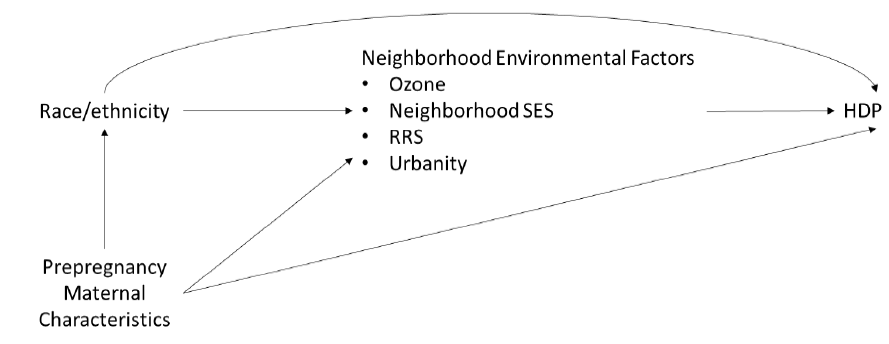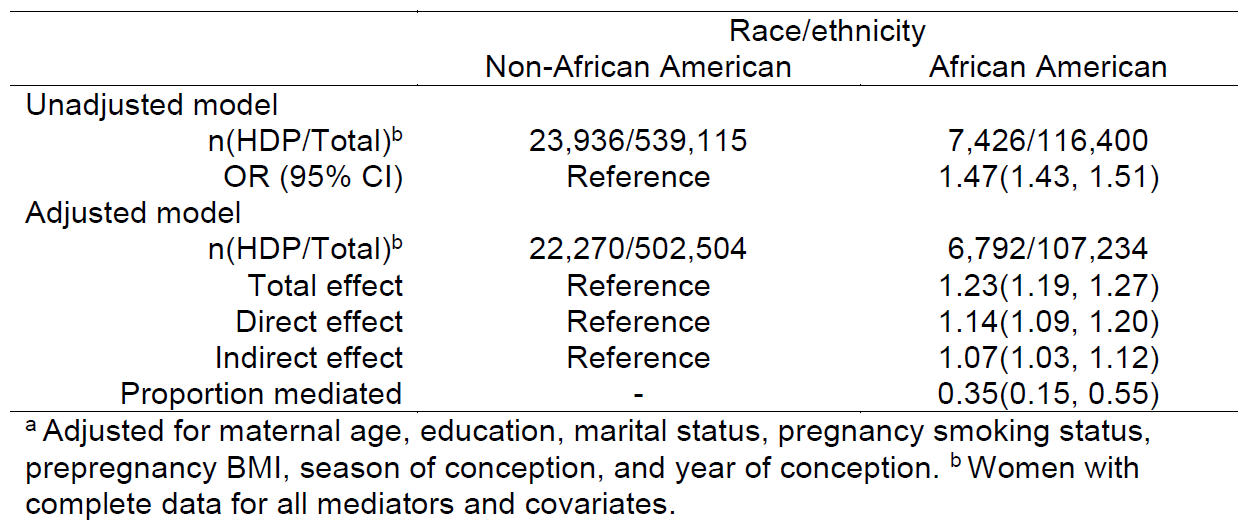PHC6937 MATERNAL AND CHILD HEALTH EPIDEMIOLOGY

Epidemiological evidence on the impact of environment on pregnancy, birth and child health outcomes
Hui Hu Ph.D.
Department of Epidemiology
College of Public Health and Health Professions & College of Medicine
September 21, 2017
Impact of Environment on Maternal and Child Health
Methodological Challenges in Studying Environmental Impacts on Maternal and Child Health
The Total Environment and Hypertensive Disorders of Pregnancy
Environment is an important health determinant
Phenotypes are a function of inherited and environmental factors
P = G + E
Phenotype
Genome
Environment
T2DM, Cancer, LBW, PTD
Polymorphisms
Infectious agents
Nutrients
Pollutants
Drugs
Genome
- There are exquisite tools that have been developed to sequence the human genome and to interrogate individual susceptibility through genome-wide association studies (GWAS)
- Thousands of GWAS

- However, there was a lack of comparable tools in relation to exposure assessment
- almost uniquely focused on single exposure-health effect relationships and no global view of how various types of exposures co-exist and jointly affect health
- A similar platform for discovery should exist for E
- why?
- Heritability: the range of phenotypic variability attributed to genetic variability in a population
- indicator of the proportion of phenotypic differences attributed to G
Exposome
- To draw attention to the critical need for more complete environmental exposure assessment
- environment is defined in this context as 'non-genetic' factors
- exposome complements the genome
- The exposome is composed of every exposure to which an individual is subjected from conception to death
- the nature of those exposures
- their changes over time
Three domains of exposome
- Three broad domains of non-genetic exposures:
- internal
- specific external
- general external

Source: Wild CP. The exposome: from concept to utility. International journal of epidemiology. 2012 Feb 1;41(1):24-32.
Three domains of exposome (continued)
- There is overlap in the three domains
- physical activity can either be internal or specific external
- The domains can also be considered as intertwined
- the internal may at least partially be a response to the external
- Measures in one domain or another may reflect to differing degrees one component of the exposome:
- the urban environment (general external)
- air pollution (specific external)
- inflammation (internal)

Source: Wild CP. The exposome: from concept to utility. International journal of epidemiology. 2012 Feb 1;41(1):24-32.



Individual's Health
Behavior and Intrinsic Biological Factors
The Total Environment
Natural
Built



Social



Ultraviolet radiation:
- May cause skin cancer and melanoma
- Recent studies also showed associations between UVR and increased mortality due to CVD, cancer, and respiratory diseases
Radon gas:
- Natural radioactive decay of uranium
- May cause lung cancer
Air pollution:
- Clean Air Act (1970, 1990)
- Outdoor air pollution:
6 criteria air pollutants - PM, SO2, CO, NOx, O3, Pb - Indoor air pollution: tobacco smoke, combustion products, radon gas
Climate change:
- Extreme temperature and precipitation
- Associated with increased mortality and morbidity
Food access, Walkability, and Greenness
- Associated with physical activity, obesity, and cardiometabolic outcomes
Lead:
- No safe level of lead exposure has been identified
- Even low levels of lead can cause neuropsychiatric function and potentially lead to behavior problems
Education, Poverty, and Safety
- Important health determinants
Environmental Impacts on Maternal and Child Health
- Pregnant women, developing fetus, and children are often especially susceptible to environmental exposures
- Multiple environmental factors found to be associated with adverse pregnancy and birth outcomes
- environmental tobacco smoke
- air pollution
- water contaminants
- persistent organic pollutants (POPs)
- pesticides
- residential greenness
- social environment
- Similar associations found for ASD, ADHD, learning capacity, and brain growth and development among children.
Environmental Contributions to Disparities in Maternal and Child Health
- Persisting large disparities
- Largely driven by individuals' SES?
- Large disparities observed among WIC participants

Mediation analyses to determine how neighborhood environmental factors contribute to racial disparities in HDP:
- The Inverse Odds Ratio Weighting (IORW):

Environmental Contributions to Disparities in Maternal and Child Health (continued)

Methodological Challenges
Hu, H., Ha, S., & Xu, X. (2017). Ozone and hypertensive disorders of pregnancy in Florida: Identifying critical windows of exposure. Environmental research, 153, 120-125.
Methodological advantages to study environmental impacts on maternal and child health
- High spatio-temporal variability of environmental exposures
It is relatively easier to study environmental impacts on maternal and child health outcomes because of the relatively short and clearly defined exposure windows
E.g. pregnancy period for pregnancy and birth outcomes
Life course approach is increasingly popular to study chronic disease epidemiology, but it poses great challenges to study environmental expsoures
Challenges
- Lack of data on residential history and activity patterns
Most environmental epidemiological studies on pregnancy and birth outcomes are based on residential addresses at delivery
- Autocorrelated exposure
Traditional methods are not able to address the autocorrelations
- Unique selection bias
Fixed cohort bias
Residential history and activity patterns
Fixed Cohort Bias
- For birth cohorts, the population at risk is constantly changing as new pregnancies start and existing pregnancies end.
- In retrospective birth cohorts, when using a study period based on date of birth (e.g. all births from Jan 1, 2010 to Dec 31, 2010), the population at risk is different at the start and end of the cohort.
2010
2011
- Fixed cohort bias:
- only the longer pregnancies at the start of the study and only the shorter pregnancies at the end of the study are included
- e.g. if there was an unusually hot month in the first trimester of the included women, then we will observe that high temperature is wrongly associated with longer gestations
Fixed Cohort Bias (continued)
- Fixed cohort bias not only bias the estimated effects of season, but also bias the estimated effects of seasonal exposures (e.g. many environmental factors such as temperature, air pollution, etc.)
- How to fix it?
- Method 1: Assuming the shortest gestation is 16 weeks, and the longest gestation is 44 weeks. We can then remove pregnancies that were conceived earlier than 16 weeks prior to the start of the study period and later than 44 weeks after before the end of the study period
- Method 2: Use a study period based on date of conception (instead of date of birth)
Distributed Lag Models
- It is important to identify critical windows of exposure to environmental factors that impact maternal and child health
- E.g. when assessing the impacts of temperature on low birth weight, we want to know what pregnancy periods are more susceptible
- Many environmental factors have high spatio-temporal variability
- day to day
- place to place
- Why traditional models cannot be used?
- Autocorrelated exposure

Hu, H., Ha, S., & Xu, X. (2017). Ozone and hypertensive disorders of pregnancy in Florida: Identifying critical windows of exposure. Environmental research, 153, 120-125.
Distributed Lag Models (continued)
- A class of models that is developed to describe associations in which the dependency between an exposure and an outcome is lagged in time
- "Exposure-response" + "lag-response" -> "Exposure-lag-response"
- Firstly applied in time series analysis, and recently generalized beyond time series design
- The general idea is to weight past exposures through specific functions whose parameters are estimated by the data
- two sets of basis functions that can independently model the exposure and lag-response relationships
- git clone https://github.com/benhhu/DLM.git
OR
https://github.com/benhhu/DLM
The Total Environment and Hypertensive Disorders of Pregnancy
Hypertensive Disorders of Pregnancy (HDP)
Most common pregnancy complication (up to 10%)
Major cause of morbidity and mortality in both mothers and babies

Image: dunyanews.tv

Large racial disparities



Individual's HDP Risk
Behavior and Intrinsic Biological Factors
The Total Environment
Natural
Built



Social



Only a few factors in the environment have been assessed, and usually separately without considering the totality of environment
Florida Vital Statistics Birth Records





Who and Where future interventions should be focused
How environmental inequity contributes to racial disparities
What risk factors require interventions



Individual-level Risk Factors Identification and Recommendation


Neighborhood-level Risk Prediction and Needs Assessment
PHC6937-MCH-Fall2017
By Hui Hu
PHC6937-MCH-Fall2017
Slides for Guest Lecture, Fall 2017, PHC6937 Maternal and Child Health Epidemiology
- 1,568



